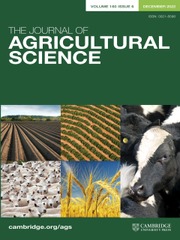No CrossRef data available.
Article contents
Some effects of infection with yellowing viruses and of fungicide applications on bolting in sugar beet
Published online by Cambridge University Press: 27 March 2009
Extract
Sugar-beet plants require an appropriate sequence of environmental conditions to change from the vegetative to the reproductive phase during the first year of growth. When plants bolt, the stem lengthens and bears flowers and the stem and root become lignified. Bolting is normally induced by a period of low temperature followed by higher temperatures and long-day conditions. The minimum time necessary, under these conditions, for initiation of bolting varies greatly with individual plants, susceptibility to bolting being genetically controlled. Intensive selection for resistance to bolting has resulted in the production of varieties which are highly resistant to bolting (e.g. Bell & Bauer, 1942; Campbell, 1953; Campbell & Russell, 1964). Elongation of the stem can be induced, without normal vernalization, by spraying beet plants with the naturally occurring growth substance gibberellic acid (Gaskill, 1957; Campbell, 1958). It has also been reported that infection with virus yellows sometimes affects the incidence of bolting (Desprez, 1959), although it has not been recorded which of the two common yellowing viruses in Europe is responsible.
Information
- Type
- Research Article
- Information
- Copyright
- Copyright © Cambridge University Press 1967

